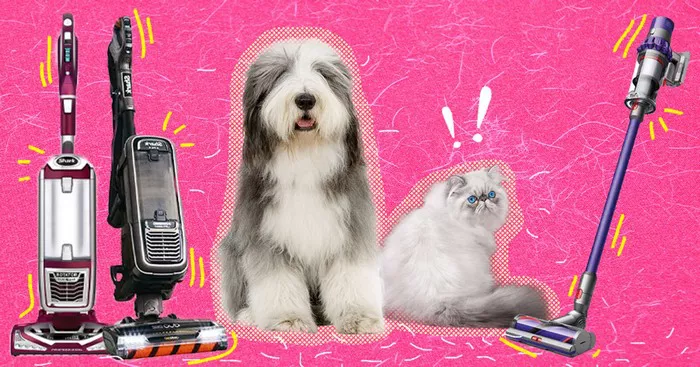Long-haired dogs are delightful companions, but their shedding can turn your home into a fur-filled battlefield. To maintain a clean and healthy environment, selecting the right vacuum is crucial. This guide will help you navigate the myriad of options available, ensuring you choose the best vacuum for long dog hair.
Vacuum Types
1. Upright Vacuums
Advantages:
Powerful Suction: Upright vacuums often come with strong motors, making them highly effective for pulling long dog hair from deep within carpet fibers.
Wide Cleaning Path: These vacuums usually have a wide cleaning head, which allows for quicker cleaning of large areas.
Disadvantages:
Weight and Maneuverability: Upright vacuums can be heavy and less maneuverable, making them challenging to use on stairs or in tight spaces.
Storage: They typically require more storage space due to their bulkier design.
2. Canister Vacuums
Advantages:
Versatility: Canister vacuums come with various attachments, making them suitable for cleaning multiple surfaces, including hard floors, carpets, and upholstery.
Mobility: The canister design allows for better maneuverability, especially under furniture and on stairs.
Disadvantages:
Setup: They can be cumbersome to set up and use, as you need to drag the canister around and manage a long hose.
Storage: Canisters and their accessories often require more storage space.
3. Stick Vacuums
Advantages:
Lightweight and Cordless: Stick vacuums are generally lightweight and often cordless, providing excellent maneuverability and convenience for quick clean-ups.
Easy Storage: Their slim design makes them easy to store, even in small spaces.
Disadvantages:
Battery Life and Suction Power: Cordless stick vacuums may have limited battery life and less powerful suction compared to their corded counterparts.
Dustbin Capacity: They usually have smaller dustbins, requiring frequent emptying, which can be inconvenient when dealing with large volumes of dog hair.
4. Robot Vacuums
Advantages:
Automation: Robot vacuums can be programmed to clean autonomously, reducing the amount of manual effort required to keep your home fur-free.
Compact Design: Their small size allows them to clean under furniture and in other hard-to-reach places.
Disadvantages:
Suction Power and Capacity: They generally have less suction power and smaller dustbins compared to traditional vacuums, which may not be sufficient for heavy shedding.
Navigation Issues: Robot vacuums can struggle with obstacles like cords and can get stuck on rugs or thick carpets.
See also: The Best Way to Mop Floors
Brushroll Design
Anti-Tangling Bristles
Vacuums designed for pet hair often feature brushrolls with anti-tangling bristles. These bristles help prevent hair from wrapping around the brushroll, reducing the need for frequent maintenance.
Self-Cleaning Features
Some high-end vacuums come with self-cleaning brushrolls that automatically remove hair from the bristles, ensuring consistent performance and reducing the hassle of manual cleaning.
Motorized vs. Non-Motorized Brushrolls
Motorized Brushrolls:
Effectiveness: Motorized brushrolls are more effective at agitating carpet fibers and loosening embedded hair.
Power Consumption: They consume more power, which can impact battery life in cordless models.
Non-Motorized Brushrolls:
Efficiency: Non-motorized brushrolls rely on suction alone, which can be less effective for deep cleaning but sufficient for surface-level fur.
Energy Saving: They use less power, making them a good choice for energy-conscious users or for use on hard floors.
Suction Power
Air Watts vs. CFM
Air Watts:
Definition: Measures the output power of the vacuum cleaner, taking into account both airflow and suction power.
Importance: Higher air watts indicate stronger suction, essential for pulling long dog hair out of carpets and upholstery.
CFM (Cubic Feet per Minute):
Definition: Measures the volume of air moved by the vacuum per minute.
Importance: Higher CFM indicates better airflow, which is crucial for picking up hair and debris, especially on hard floors.
Filtration
HEPA Filters for Allergy Sufferers
Definition:
HEPA (High-Efficiency Particulate Air) filters trap 99.97% of particles as small as 0.3 microns, including pet dander and other allergens.
Importance:
Allergy Relief: For households with allergy sufferers, HEPA filters are essential to keep the air clean and reduce allergic reactions.
Cleaner Air: Even if no one in your household has allergies, HEPA filters ensure a cleaner living environment by trapping fine dust and allergens.
See also: Electric Broom: A Quick Guide to Technology and Use
Additional Features
1. Maneuverability
Swivel Steering:
Improves navigation around furniture and obstacles, making cleaning more efficient and less physically taxing.
Weight:
Lightweight vacuums are easier to carry, especially when cleaning multiple levels of a home.
2. Attachments
Crevice Tool:
Essential for cleaning tight spaces, corners, and along baseboards where dog hair tends to accumulate.
Upholstery Tool:
Designed to remove hair from furniture, car seats, and other fabric surfaces.
Pet Hair Tool:
Specialized attachments specifically designed to handle pet hair more effectively than standard tools.
Top Considerations
Budget
High-End Models:
Offer advanced features like self-cleaning brushrolls, HEPA filtration, and superior suction power, but come with a higher price tag.
Mid-Range Models:
Provide a balance of performance and cost, with essential features like motorized brushrolls and decent filtration.
Entry-Level Models:
More affordable but may lack some advanced features, suitable for those with a smaller budget or lighter cleaning needs.
Lifestyle
House vs. Apartment:
Households: Larger spaces may benefit from powerful upright or canister vacuums with extensive reach and large dustbins.
Apartments: Smaller spaces might be better served by compact, lightweight stick or robot vacuums.
Pet Hair Volume:
High Shedding: Homes with multiple long-haired dogs or heavy shedders will need vacuums with strong suction, large dustbins, and robust brushrolls.
Moderate Shedding: For homes with lighter shedding, a mid-range vacuum with essential features might suffice.
Conclusion
Selecting the best vacuum for long dog hair involves considering various factors, from vacuum type and brushroll design to suction power, filtration, and additional features. Upright and canister vacuums offer powerful suction and versatility, while stick and robot vacuums provide convenience and ease of use. Brushrolls with anti-tangling and self-cleaning features, coupled with strong suction and HEPA filtration, ensure effective removal of long dog hair and allergens. Ultimately, your choice should align with your budget, lifestyle, and the volume of pet hair in your home to keep your living space clean and comfortable for both you and your furry friends.

